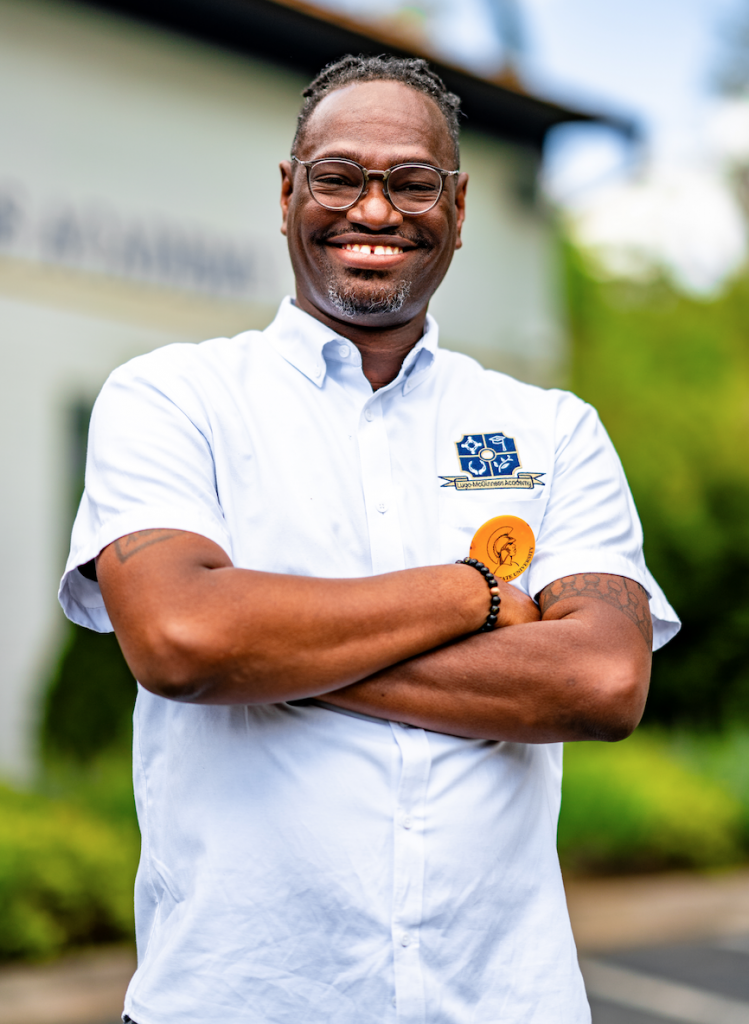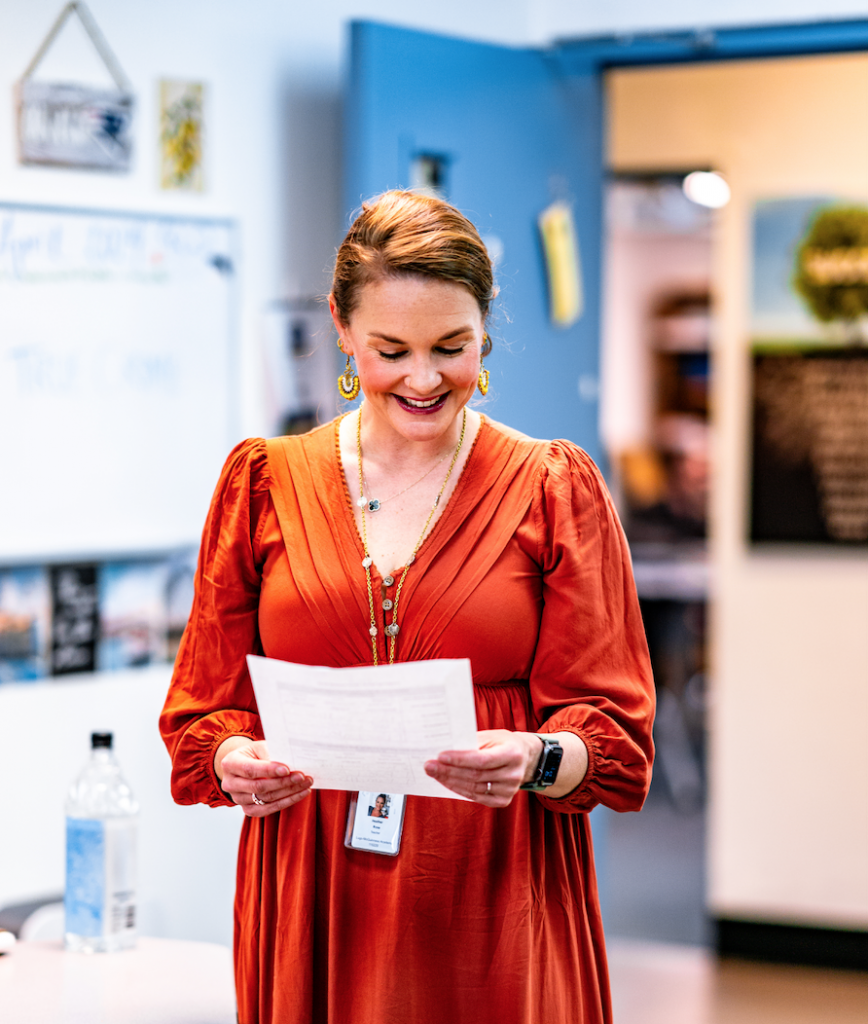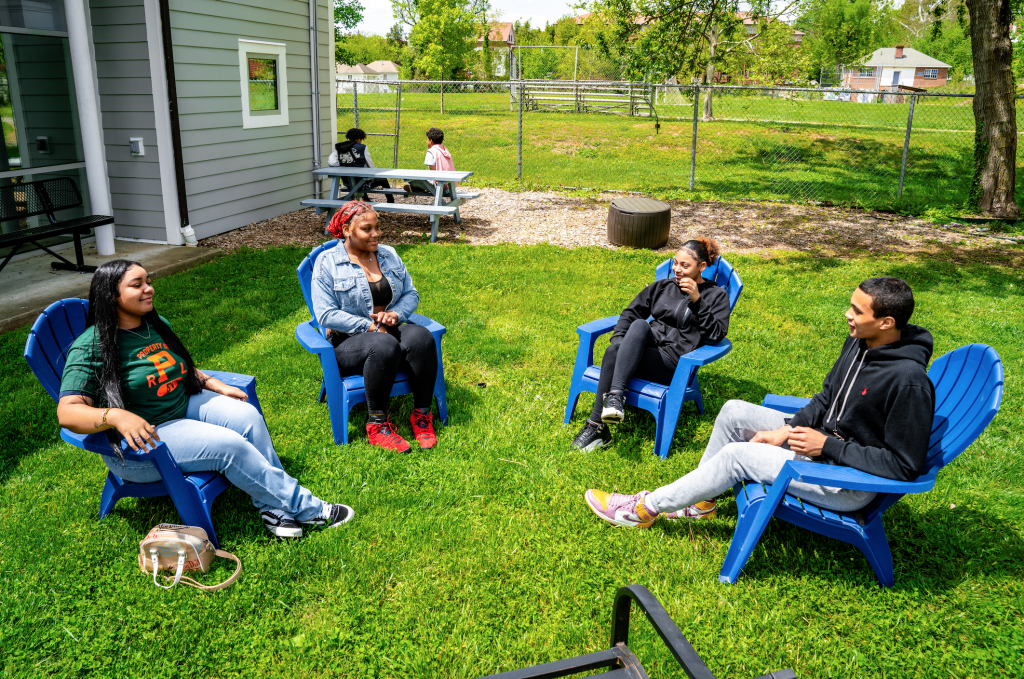Nestled at the edge of the 10th and Page neighborhood, Lugo-McGinness Academy looks like a miniature version of a typical American high school. The alternative school is sandwiched between houses, standing out with its parking lot, two-building campus, solar panel-covered tin roof, and cyan columns that frame the main entrance.
Compared to Charlottesville High School, LMA is tiny—which is what makes it so special.
“It’s unique because it allows us to build a foundation for student relationships, being able to connect with our parents on an intimate level to address the academic, behavior, and social needs,” says Program Director and Principal Lamont Trotter. “Students have the opportunity to have a smaller academic environment where they can see success and feel success.”

In addition to the Lugo-McGinness day program, the campus also hosts Charlottesville City Schools’ newest alternative program, Knight School, in the evenings.
Alternative education came into the local spotlight last fall, when student fights at Charlottesville High School prompted unexpected closures and the launch of Knight School. The new program is the first nighttime offering from Charlottesville City Schools, and joins LMA and Charlottesville-Albemarle Technical Education Center as major alternative programs available through the district. CCS also offers a program for patients at the University of Virginia Children’s Hospital.
Each alternative education program has different offerings and enrollment methods, including referral and self-selection.
Along with sharing a building, Knight School and LMA have other commonalities aimed at helping students improve their relationship with school, academics, and attendance. Trotter and other faculty members pick up students in both programs to make sure transportation isn’t an obstacle.
“We’re dashing through the streets of Charlottesville picking up our young people for school,” says Trotter. “We want to make sure students are attending school. We want to minimize any barriers that may be provided. And so that’s something that we share at our orientation about transportation: if it’s needed, we can help provide that.”
Walking into LMA’s main building, students pass a reception desk and conference room before heading into a single hallway filled with classrooms. Situated on the back right is English and journalism teacher Heather Rose, who has been an instructor at LMA since February 2023.

Photo by Tristan Williams.
Prior to coming to Charlottesville, Rose experienced burnout and contemplated quitting teaching. The tight-knit community at LMA convinced her she was in the right place and the right field.
“When you think of alternative education, you think of it as a punitive thing, and I think that sometimes alt-ed is used for that,” she says. “[But] the school culture here is really powerful in a positive way.”
Beyond her role as an educator, Rose says she and the rest of the LMA faculty “kind of all wear all the hats at times.” The small nature of the alternative school and its community—less than 40 students are enrolled in the day program—allows for not only individualized instruction, but closer relationships between students, their families, and faculty members.
Students are often already hanging out in Rose’s room when she walks in, working in comfy chairs and catching up with their classmates. One student, Tay, is sitting by the wall working on his Chromebook. After attending CHS for three years, the senior switched to LMA, and is now working toward graduation.
“Teachers [here] care about the students. They really care about you and they want you to learn. … Everybody just wants you to be great,” he says. “Before we get to work, [they] make sure you’re good.”
Rose’s class is informal, with students congregating around the room, chatting and mostly working at their own pace. Despite the laid-back atmosphere, coming to LMA has been a complete game changer for many students’ academic futures.
“I’m passing all of my classes, which is very surprising, because when I was at CHS, I was at risk of not passing all of my classes, I was at risk of failing,” says Jaylyn. “People here, they’re kind of friendly. They’re open about almost anything and they’re willing to sit down and help you.”
The small community at LMA has also helped students socially by removing some of the pressures and challenges of a bigger school.

As students mill around the cozy classroom, they talk to not only each other, but Rose and her student teacher, Laura Boyle. Classes average around eight to 10 students, with attendance ranging from two to six students, according to Rose. For many of the teens at LMA, the relationships with their peers and teachers are what keep them coming to class.
“I have people I can talk to … And places I can go when I’m not feeling comfortable here,” says Tam-Rah. “We don’t have to worry about walking around here, starting problems with anyone, cause no one here is rude and everyone here has good communication.”
While some of the students at LMA are at the program due to self-selection, others have been referred because of academic, disciplinary, or behavioral problems. Regardless of why the kids are at the school, every faculty member at LMA emphasizes how much all students benefit from the intimate environment.
“I think because of that we’re able to give so much more grace here,” says Boyle, who is in her final semester of a masters in education and wrapping up her time at LMA. (I know Boyle from a four-person seminar at UVA, but I didn’t know she was a student teacher at LMA prior to visiting.) “That focused attention and just a smaller environment, I think, has been so special and cool to watch.”
“Kids might be sent here because of a poor choice they made or poor behavior, or pattern of behavior. But when they walk through these doors, they’re not bad kids to us and we don’t treat them like that,” says Rose. “We don’t see that side of them for the most part, which is so encouraging.”
When students feel truly comfortable in a space or with a teacher, they occasionally lash out. It can be heavy for educators to process, but at the same time, Rose says she understands that it’s ultimately a sign of trust.
“We’re alternative, we’re [a] different dynamic for students that need it and they’re just able to be their best selves I think, and even when they’re their worst selves, there’s so much grace here,” says Rose. “There’s so much recognition of, ‘we see you where you are, but we are still gonna have expectations for you. And we still want to encourage you to grow. But we’re going to help you and support you to get there.’”
As the school counselor for LMA and Knight School, Aloise Phelps spends a lot of time working one-on-one with students. Part of her job is managing schedules, but an overwhelming majority of her time is spent on direct counseling.
“There’s a tendency to label kids as the ‘bad kids’ … but we have done such a good job at LMA of fundamentally believing that every single child is a good kid, and that they are having a hard time so their behaviors may exemplify that in some way,” says Phelps.
Working through trauma and its effects with students has been a large focus of Phelps’ first year at LMA—something she says is also common in her work with Knight School students.
Visiting Knight School, which launched in November, it’s clear students haven’t yet built the same bonds as their peers in the LMA day program, but the counselor and other faculty members are working to create a welcoming environment.
Three students were in Melvin Grady’s math class when I visited Knight School. Unlike the day program, the students mostly kept to themselves, but they participated when prompted.
“At bigger schools, students can roam around, not go to school, be in class unnoticed,” says Grady. In the intimate setting of LMA and Knight School, the math teacher has more ability to provide individualized instruction and help students when they get stuck.
Across the hall, the kids are more talkative. It’s not immediately clear what subject is being taught or what work each student is doing, but the relationships that have made LMA’s day program so successful are being built.

Photo by Tristan Williams.
“The last thing I do is teach math, first thing is to reach common ground. Still structured though, don’t get it twisted, I do expect certain things,” says Grady, who takes this approach with both his day and night students. “You’re not gonna disrupt the learning environment, then you have to go. But other than that, they recognize the caring and the realness.”
While the program was launched in the wake of the unexpected closure of CHS last fall, Knight School is something Superintendent Royal Gurley was already aiming to bring to CCS. Gurley has a background in alternative education, and was involved in the launch of a night program in his former district. Part of the draw of Knight School is the timing, but similar to LMA, the superintendent and program leaders are working to build community through one-on-one instruction and a smaller environment.
Whether it be LMA, Knight School, or CATEC, Gurley emphasizes the importance of having options for kids other than a traditional learning experience.
“People think that alternative education is where you dump kids, where you leave kids, where you give up on kids, where you just move everything you don’t want to deal with, you just move it to alternative education,” says Gurley. “What we have done as a school system … to say that we are where kids get their hope from, that they can be anything that they want to be, that we will work with any type of student and we will accentuate the best in any student.”
“We do not work from the deficit mindset, when we’re talking about students. We’re only seeking the best, there is good in everyone,” says Gurley. “Students can be successful when they have a space to be successful. And sometimes it’s just that the high school, which is a great high school, is just not the space because it’s too big. It doesn’t work for every child.”
